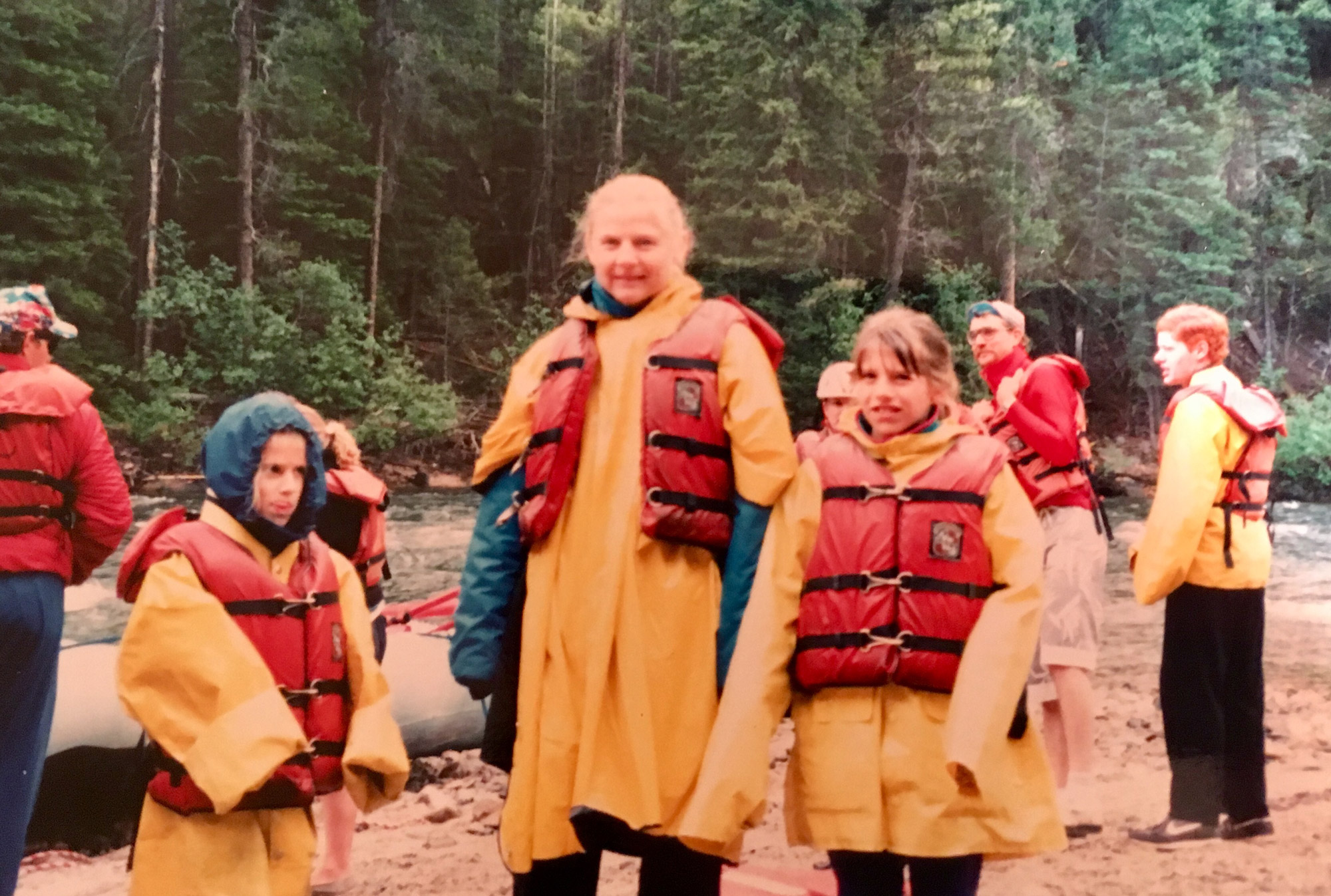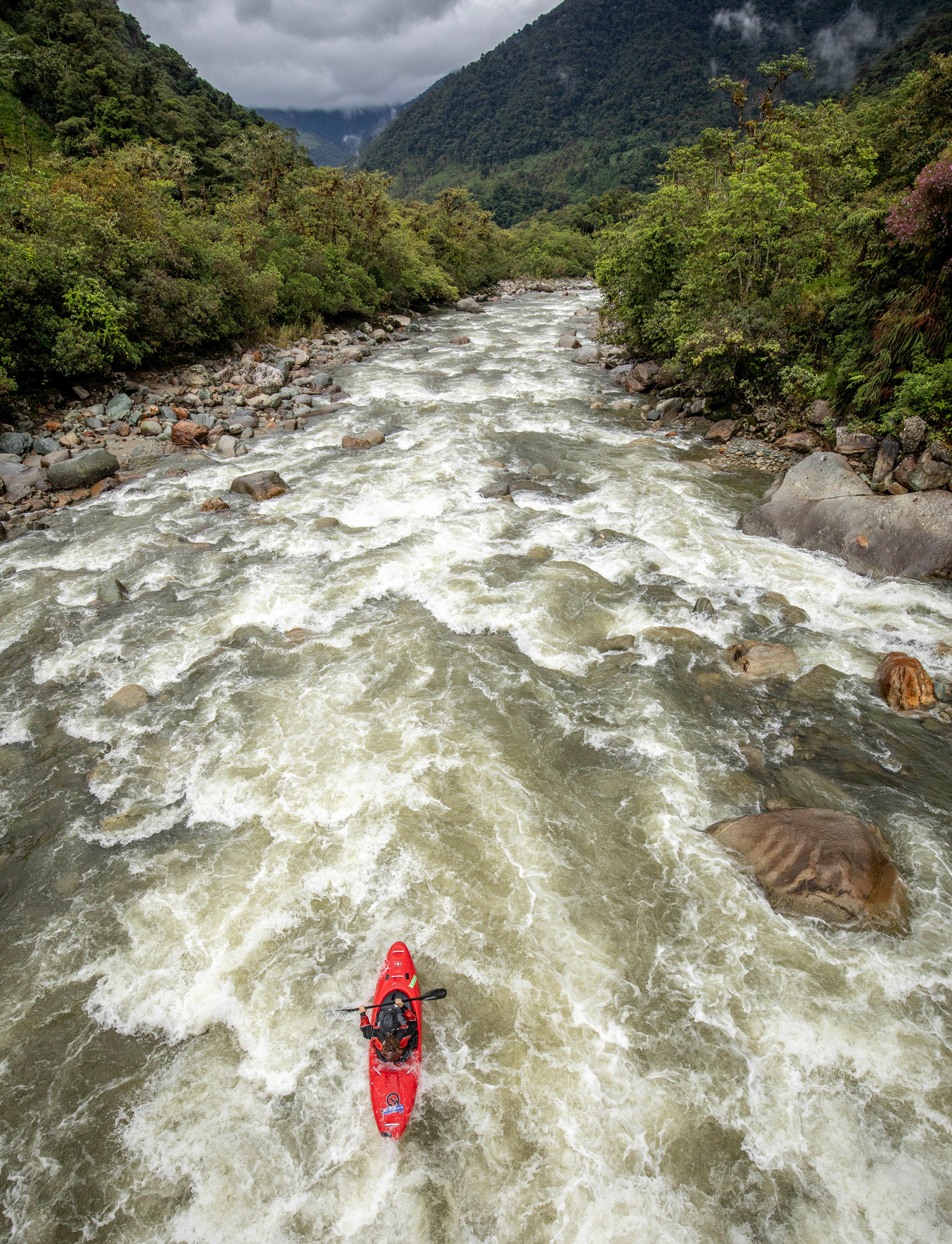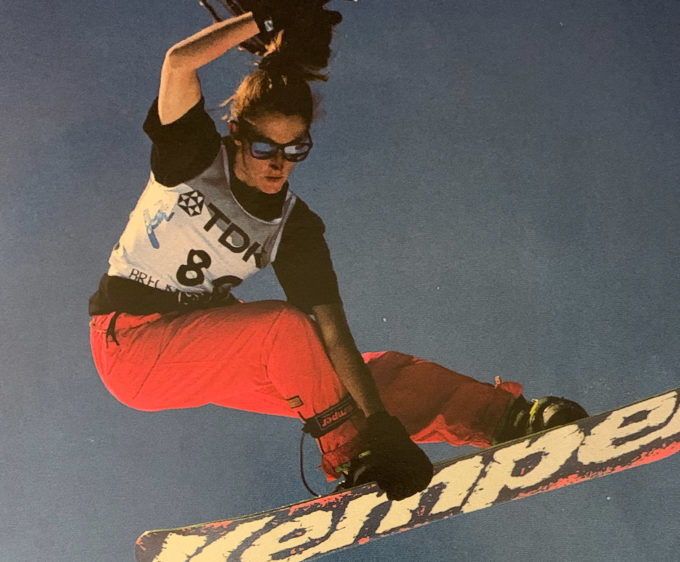
Darcy Gaechter: Kayak Queen
Bandits, haircuts, sexism and a lot of capsizing. Darcy Gaechter’s journey from newbie to world-class expedition kayaker changed the sport forever
By Sam Haddad
Darcy Gaechter is the first and only woman to have kayaked the Amazon, the world’s largest river, from its source in the Peruvian Andes to the Atlantic Ocean. It was a phenomenal 148-day feat, which blew all preconceptions of what a woman could achieve in a kayak out of the whitewater. This is her amazing story.

Darcy didn’t start kayaking until she was in her late teens, though as she grew up in Aspen, deep in Colorado’s Rocky Mountains, she did spend an enviable amount of her childhood outdoors. Her dad was a ski patroller who taught her to ski at two, but while she always enjoyed being on snow, she wasn’t drawn to competitive ski racing. “I wasn’t into doing sport for sport’s sake,” she says. “It was more playing outside, climbing trees, playing in rivers – that was a big part of our lives.” If she ever told her mum she was bored, she’d be sent out into nature to play, and told not to come back until dinnertime.
From an early age, Darcy liked to test herself with little challenges, such as walking across rivers or scaling particularly difficult trees. At 13, she was allowed to go camping with her friends. “My parents would drive us to the campground and then come and pick us up in the morning. It was always super-exciting and helped us feel like grown-ups, as if we could take responsibility for ourselves,” she says.

Darcy was also fortunate that her local school ran an outdoors education programme for a week every summer. On these trips, the teachers would give the kids a fair amount of leeway to hike and explore the natural landscapes by themselves, trusting them to be independent and find their way back to camp. “We obviously made mistakes along the way, but we always made it back in the end. It was good; it helped us grow,” she says.
Darcy was often singled out for being good in the outdoors. She found that trust from her teachers empowering and thinks it really helped her stay on track during her teenage years, when the temptations to rebel are at their most compelling. “In high school, there were probably a couple of points where I could have gone down a more deviant path, but fortunately I got more into outdoor activities instead,” she says. “I think that encouragement from the teachers, not overtly telling me I was good at it, but saying: ‘Oh, you can hike there if Darcy’s going, we trust it’ll be OK,’ made me think I should stay focused on that path rather than, say, drinking or drugs. I’m very thankful to them for that.”
Somewhat surprisingly, given the mould-breaking expedition kayaker she would become, one of Darcy’s first experiences on a river almost ended in disaster. “We were that stupid family you read about in the news,” she explains. “We literally went to Walmart, bought a raft, and then my mum dropped my dad and me off at a little park near their house. Nowadays there’s a sign warning about the class-four rapids downstream, which says: ‘Expert Only’, but back then there was no sign. It was so cold, the blades fell off the ends of the paddles and floated away, so we just had these two little sticks. Then we capsized, lost the raft and had to hike in a huge hail storm wearing just T-shirts and shorts.” But that near-death encounter didn’t remotely put her off. “For some reason, I thought: ‘Oh, I kind of like this,’” she laughs.
When she graduated from high school at 18, Darcy got a job as a raft guide. All the other guides were in their early 20s and massively into kayaking. Darcy really looked up to them, so she decided she had to learn to kayak so that she could hang out with them more. The only other woman raft guide had given up kayaking after a bad experience, but she lent her kit to Darcy so she could get started.

Endurance
The guys would tolerate her going with them to a local class-three (intermediate) rapid spot, but they weren’t interested in teaching her how to kayak at all. “I was the only woman, and much worse than all of them,” says Darcy, “I hated it. I was always capsizing and having to swim out of my kayak and rescue everything, while everyone waited for me. I was so embarrassed. I’d never been truly bad at anything before and I was truly bad at it. I was super-apologetic to them but, of course, in my head I was constantly thinking: ‘Don’t mess up or they’ll never let you come again.’”
But she also had this sense that she couldn’t give up and let kayaking win – that she just had to persevere and get on with it. A friend helped her learn how to do the combat roll when she tipped over, which was a “huge game-changer”, as she no longer had to swim out of the boat.
Then that same friend invited her to join a trip to Nepal in 1998, when she was just 19, which would prove even more transformational in her kayaking career – and her life more generally. “I still wasn’t a very good kayaker, and I’d tip over at every rapid, but it was also the first time I’d left America, which was really eye-opening,” she says. They visited rivers that took days of hiking to reach, and met villagers who spoke no English. “It was fascinating,” she says. “Getting way out there with your kayak and then meeting people who have such different lives to you, that’s what really hooked me in.”
She did, and still does, the odd whitewater race but from Nepal onwards, she wasn’t tempted to go down the Olympic route for kayaking and enter the canoe slalom or sprint events. “The whole race idea, where you train at a slalom course and do a race that takes up the whole day and you only get to kayak for 20 minutes, didn’t appeal to me,” she explains. “From that early trip to Nepal, I wanted to get as good as I possibly could, to run the most challenging rivers in the world. To do expeditions and get way into remote river canyons to see beautiful places. Competing might have helped my skills, but I thought it would take too much time away from the part of kayaking I really loved.”


By travelling on a river, through the heart of a country, Darcy knew she was seeing something that foreign visitors didn’t usually get to experience. “Unless you’re kayaking, rivers and the land around them are often quite inaccessible. You get to see these amazing canyons, or settlements dotted along the river. They’re not places regular tourists would have any reason to go to,” she says. “We later went to Europe but we never went to Rome or saw the Eiffel Tower. We missed all the classic things, but for me it’s fun to see stuff or meet people who have perhaps never seen an American before – that’s really sort of special.”
How long did it take her to feel like she was any good at kayaking? “Probably three years,” she says. “At that point, my competence and mental image of myself had gone beyond what my true skills were but, in a weird way, in kayaking that’s helpful. Being delusional can obviously get you in a lot of trouble, but confidence on the river and the belief that you can do it is incredibly helpful to your actual physical performance. It’s really helpful to be relaxed and keep your hips relaxed so you can absorb the river.”

On a trip to Ecuador, she met Don Beveridge, an accomplished kayaker and guide, who ran trips in the country through Small World Adventures; Don would later become her husband. Darcy credits Don and his business partner, Larry Vermeeren, with taking her kayaking to the next level. “They helped me take whatever skills I’d built and gave me some good experience in scouting and getting smart about the river. What do you look for, and how do you decide if it’s really right for you to run it?”
Before long, Darcy joined the company as its only woman guide and she has been there ever since, leading trips on rivers all over the world. Has she experienced much sexism or many men doubting her credentials during that time? “I’m curious about whether it happens less now or I just care less now, as I’m more confident in my own skills. But yes, especially when I was a raft guide, and it used to really bother me. Some guy at the put-in would pull one of the male guides aside and say, ‘Please don’t stick my family with that little girl over there.’ And you would definitely get some guys who were adamant about proving they were better than me – they didn’t want to be told where to go by a woman, or rescued by a woman. That’s always a funny thing, as they’ll push you out of the way and say, ‘I can empty my own boat!’ – which is more than fine with me.”
The idea to kayak down the Amazon river from source to sea wasn’t actually Darcy’s or even Don’s. It came from a client on one of their Ecuador trips, a Londoner called David Midgley. He was in his mid 30s and, according to Darcy, was “having a midlife crisis of sorts” and wanted a big adventure. Everest felt too done, as did sailing around the world. Then he read that more people had walked on the moon than descended the Amazon, and that no one had ever done it on a kayak. With the challenge set, he asked Darcy and Don to train him. “He didn’t know how to kayak, he’d never even been camping! It really is an amazing story,” says Darcy. “He said we needed to make him into a class-five (expert) kayaker. We didn’t imagine he’d stick at it, but he did, and 10 years later, when he was ready, he invited us to go with him.”
While Darcy and Don did turn “Midge”, as they called him, into a technically strong kayaker, Darcy says he never quite developed the expedition or scouting skills, though that didn’t matter, as that’s what they were there for. The three of them physically paddled down the Amazon river from source to sea, making Darcy the first and only woman ever to achieve that feat.

It would be easy to think that the most difficult part of their trip was navigating the steep sections of rapids or small waterfalls. And they did once have to hike for two hours, carrying all their kit around one waterfall, as it was on a construction site and the safe line appeared to be blocked by rocks. But for Darcy it was the calm, flat water that was the hardest. They had 25 days of whitewater, paddling eight to 10 hours a day, and then 123 days of flat water.
“Whitewater is more fun, but it’s also more challenging, so it really forced us to work together as a team,” says Darcy. “We all did really well and got along in the whitewater. But in the flat water, it was boring, we were tired and grumpy and had no external threat to make us work together as a team, so we turned our negative energy towards each other and did a lot of bickering.” The group also struggled with sleep in the flat water as it was so much hotter there than in the mountains where they’d begun. And they had to worry about pirates…
“When the whitewater ended, our next 30 days of travel were through what Peru calls ‘the red zone’,” says Darcy. “It’s the number one cocaine-producing region in the world, 80% of the wood harvested there is cut down illegally, and there are still Shining Path Maoist guerrillas, who the year before we were there murdered two tourists who were paddling through.”
The group was understandably very concerned about bandits along this stretch, so they had a local guide join them in a motorised canoe, and then, in the final week, had the Peruvian Navy as an escort. Darcy also decided to cut off all her hair, so that it would appear from a distance as if they were three males. “I thought people would be less likely to mess with us,” she says. “But then, of course, when we got to a place and I would start talking, they would know that I wasn’t a man, and they would really relax. I don’t know if cutting my hair was a good idea, but it just seemed logical at the time.”

Did they have any scary confrontations? “One day, we saw a couple of guys hiding behind some rocks on the river banks with shotguns, looking at us, but again they were very nice and helpful when they realised what we were doing.” Darcy is obviously very strong, but she’s also small and slight in build. Does she think kayaking the Amazon was harder for her than it was for her husband, who is 6ft 1 and weighs almost twice what she does? “There are pluses and minuses to being big or small,” she says. “Don carries more momentum, so is less likely to get stuck in a hole between rapids, and carrying the heavy kayaks and all the other kit is obviously easier for him. But I’m more agile, so getting out of the boat in precarious spots is more straightforward for me.”

Paddling the length of the world’s largest river was an amazing achievement, which marked out Darcy, then 35, as a real star in the world of whitewater expedition kayaking and beyond, especially when her book, Amazon Woman, was published in 2020. However, she admits that she’s not always hugely comfortable in the spotlight. “I’m very shy and introverted. If I had my way, I’d just hide out in the river canyons forever and not talk to people,” she says, laughing. “But while I’m not great at being vocal or organising women’s advocacy groups, I feel like my contribution to the world is leading by example. Not many people believe that short, skinny, wimpy-looking women can do all this stuff, and showing them that I can, that any small woman can, feels like my mandate.”
Next year, Darcy and Don are planning an expedition to the Stikine Plateau in northern British Columbia. She’s inspired by the First Nations people living there, who have fought against extractive industries, including big mines and dams, for decades. “Modern society is great, but it does really cut us off from our history and connection to the natural environment,” she says. “Rivers link us to the past and I really admire the way the First Nations people there are living and fighting and doing what they need to do to protect their land and way of life to pass it on to the next generation. There are lessons for us all in that stewardship.”

Editorial Design by this is root




